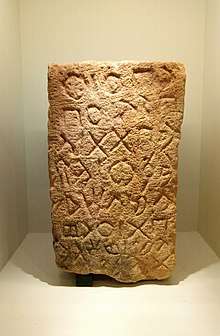Minaean language
The Minaean language (also Minaic, Madhabaic or Madhābic) language was an Old South Arabian or Ṣayhadic language spoken in Yemen in the times of the Old South Arabian civilisation. The main area of its use may be located in the al-Jawf region of North-East Yemen, primarily in the Wādī Madhāb. Most of texts in this language were composed by the Minaeans, but the other civil-temple communities of the Wādī Madhāb (Nashshan, Kaminahu, Ḥaram, and Inabba') also used it as a literary medium.
| Minaean | |
|---|---|
| Native to | Yemen |
| Era | 1200 BC – 100 AD |
Afro-Asiatic
| |
| Language codes | |
| ISO 639-3 | Either:inm – Minaeanxha – Harami |
inm Minaean | |
xha Harami | |
| Glottolog | mina1279 Minaean[1] |
History

The earliest Minaean inscriptions are contemporary with the earliest Sabaean ones, i.e. the 8th century BCE, though they are less numerous, and come from the cities along Wadi Madhaab, to the north-east of Ma'rib. Minaean trading posts, and Minaean inscriptions are also found outside South Arabia, as in the ancient oasis of Dēdan (the present day Al-`Ula in Saudi Arabia), and even on the Greek island of Delos and in Egypt. Minaean seems to disappear as a written language about the end of the 2nd century BCE.
Phonology
The phonology of the ancient Minaean language seems to be essentially similar to that of the other Old South Arabian language. One peculiarity of Minaean is that it writes the phoneme /s/ in foreign names as /ṯ/ (e.g., Delos becomes dlṯ [2]), but still keeps the phoneme distinct in native words.[3]
Minaean seems to insert an etymologically unexplained h in certain nominal endings, pronouns and particles; some plurals also exhibit this same feature: bhn and bhnt, plurals of bn (son). These may be plene writings of a long vowel other than /u:/ or /i:/.
Grammatical Features Peculiar to Minaean
Due to the limited amount of texts that have survived, many forms are not attested, though hopefully the discovery of new texts will provide us with more source material. In Minaean external plurals seem to be especially common; an -h is often used at the end of words in the construct state, even in the singular.
Minaean Nominal Endings
| Construct | Indeterminate | Determinate | |
|---|---|---|---|
| Sing. /broken plur. | -h, no ending | -(m) | -n |
| Dual | -y, -hy | -ny | -nhn, -nyhn |
| External Plural | -hw, -hy | -hn |
(Compare the table given under Sabaean language.)
Relative Pronouns
| Masculine | Feminine | |
|---|---|---|
| Singular | ḏy- | ḏt |
| Dual | ḏy | ḏtyn |
| Plural | 'hl, hl | |
Particles
Whereas Sabaean uses the preposition l- to mean "to(wards)", or to express the dative case, Minaean often has k- (compare Ḥaḑramitic h-). The particle k- has a prefixed s2 in Minaean, as in bn s2-kḏ [4] "from (the possibility) that ...". Minaean, like the other non-Sabaean languages also has a temporal conjunction mty ("when").
The Minaean negative particle, which has been so far badly attested, is lhm.
Verbs
Minaean is distinguished from the other Old South Arabian languages by having an extra form for verb stems with a reduplicated second radical, spelled fˁˁl (as in ˁlly, "raise" [5])
Conjugation of the Perfect Tense
Minaean, like the other South Arabian languages, forms the Perfect tense by adding suffixes. Unlike the other dialects, however, it does not write the dual and plural endings, they are therefore the same as the singular; for example: s3l' ("he/they dedicated").
References
- Hammarström, Harald; Forkel, Robert; Haspelmath, Martin, eds. (2017). "Minaean". Glottolog 3.0. Jena, Germany: Max Planck Institute for the Science of Human History.
- Inscription: R3570/3.
- Roger D. Woodward: The Ancient Languages of Syro-Palestine and Arabia. Article of Nebes and Sterin: Ancient South Arabian. Pg. 150.
- Inscription R 2980/13 = Shaqab 19/13)
- Inscription: M 203/2.
Bibliography
- Leonid Kogan and Andrey Korotayev: Sayhadic Languages (Epigraphic South Arabian). Semitic Languages. London: Routledge, 1997, p. 157-183.
- Andrey Korotayev. Ancient Yemen. Oxford: Oxford University Press, 1995. ISBN 0-19-922237-1
External links
- Corpus of Minaic Inscriptions from the Digital Archive for the Study of pre-Islamic Arabian Inscriptions (DASI)